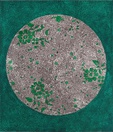Daniel Boyd
Sydney
2023
Displayed 2023 at Museum of Contemporary Art Australia

Daniel Boyd
Kudjala, Ghungalu, Wangerriburra, Wakka Wakka, Gubbi Gubbi, Kuku Yalanji, Bundjalung and Yuggera
Born 1982, Gimuy/Cairns, Queensland
Lives and works Sydney
Daniel Boyd is an artist of Aboriginal and Pacific Islander heritage who critically engages with the colonial history and archival documentation of the Australia-Pacific region in his work. Boyd’s works are held in major public collections including the Art Gallery of New South Wales, the National Gallery of Victoria, the Museum of Contemporary Art Australia, the Samdani Art Foundation, the Museum of New Zealand Te Papa Tongarewa and the Natural History Museum, London. Boyd’s work has featured centrally in many exhibitions in Australia and internationally, including major career survey, Treasure Island, at Art Gallery of New South Wales, Sydney (2022); Do We Dream Under The Same Sky, Okayama Art Summit, Okayama (2022); In Between, Australian Pavilion, 17th International Architecture Exhibition, Venice Biennale, Venice (2021); 2077, Kathmandu Triennale, Kathmandu (2022); and 경로를 재탐색합니다 UN/LEARNING AUSTRALIA, Seoul Museum of Art, Seoul (2021-22). In 2018, Boyd was commissioned by the Australian War Memorial, Canberra, to create For Our Country (2018-19), an Aboriginal and Torres Strait Islander Memorial.
Photograph: Josh Morris
Image courtesy the artist
Artist text
by Lara Strongman
There’s a plate in the Chau Chak Wing Museum that used to belong to Robert Louis Stevenson. I imagine he brought it with him from San Francisco and ate dinner from it when he lived in this part of the world – he travelled in the Pacific with his family from 1888, visiting Sydney and settling finally in Apia, where he died in 1894. Stevenson’s plate is an unremarkable piece of china, late Victorian transferware from the Ridgway Potteries in Stoke-on-Trent. It’s patterned in widely spaced orange flowers which look quite like English hedgerow campions, but the name of the pattern is ‘Persia.’ It’s a design that was widely exported to the US. In fact, you could pick one up right now on eBay for less than $100, were you so inclined.
Stevenson’s plate is the subject of several works by Daniel Boyd. Perhaps I’m wrong to call it his subject, though: better to say that Boyd has painted versions of the plate, in different colours and at different scales, several times. In The National 4, the plate and Boyd’s paintings of it are exhibited side by side.
‘I’m interested in proximity,’ says Boyd. ‘It would have been present at conversations at dinner every night. When he passed away, it ended up in the museum collection. I like the idea of these objects that move between contexts. I'm tracing them in a nonlinear way.' (1)
Stevenson’s most famous novel was Treasure Island (1882), a rollicking adventure story set on a desert island. Treasure Island is also the title of a major painting Boyd made in 2005, a version of the Australian Institute of Aboriginal and Torres Strait Islander Studies (AIATSIS) map of Australia showing where Indigenous languages were spoken prior to 1788. In a related work, he painted a version of Emanuel Phillip Fox’s Landing of Captain Cook in Botany Bay, 1770 (1902), giving Cook a black eyepatch and adding a skull-and-crossbones to the unfurled Union Jack flag planted on Dharawal land. ‘They call them pirates out here,’ Boyd wrote in paint under the image.
Perceptions of a place, says Boyd, ‘can be tainted by a fiction.’
While it has been influential on a century of fictional representations of pirates, Stevenson’s story of an uninhabited, distant island filled with treasure ripe for the plunder may also be seen as an allegory for the colonial project. Convenient fictions, and misrepresentations of place and of peoples, were a colonial stock-in-trade, and they have continued to shape perception.
Over the last decade, Boyd has developed an approach to painting which acts as a powerful form of resistance to the pervasive fictions of colonial history. He covers his paintings with translucent dots that both obscure the image and refract it into an abundance of lenses which deny a singular view. A system of titling his work with unexplained acronyms makes it clear that not all knowledge is available to the viewer: some is held back by the artist. In his use of existing imagery drawn from museum or archival collections, or in his representation of enigmatic objects adrift in the world like Stevenson’s dinner plate, Boyd asserts an Indigenous re-vision of history. In bringing the original object – itself a multiple – together with its painted version, Boyd, as he puts it, ‘expresses the poetic in opposition to the definitive.’
(1) All quotations drawn from an interview between the artist and author, November 2022.
Artist's acknowledgements
Daniel Boyd is represented by Roslyn Oxley9 Gallery, Sydney, STATION Gallery, Melbourne, and Kukje Gallery, Seoul.




